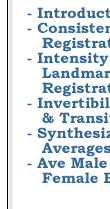
 |
|||||
 |
|||||
Next: Acknowledgments Up: index Previous: Landmark and Intensity Registration
Summary and Conclusions
This work presented two new image registration algorithms based on thin-plate spline regularization: landmark-based consistent thin-plate spline (CL-TPS) image registration and landmark and intensity-based consistent thin-plate spline image registration (CLI-TPS). Experiments in 2D were used to show that the inverse consistency error between the forward and reverse transformations generated from the traditional unidirectional thin-plate spline algorithm(UL-TPS) could be minimized using the CL-TPS algorithm. Inverse consistency error images showed that the largest error occurred away from the landmark points for the UL-TPS algorithm and near the landmark points for the CL-TPS algorithm. The maximum CL-TPS inverse consistency error was reduced by 500 times in the inner-to-outer dots example and greater than 6 times in the 2D MRI brain example when compared with the UL-TPS registration. The Jacobian error was reduced from 1.4 to 0.0012 for the inner-to-outer dots example and from 0.050 to 0.034 for the MRI brain example. Using landmark and intensity information with the MRI brain example gave a better intensity matching between the images than just using the landmark information as visualized in Fig. 8 and by a decrease in the average intensity difference recorded in table III. It was shown that using both landmark and intensity information gave a better registration of the MRI brain images than using the intensity or landmark information alone.Although the results presented in this paper are restricted to 2D experiments, the extension of the algorithmic principles to 3D is straight forward. A few of the issues involved with going from 2D to 3D include, the 3D implementation require more computer memory and computation time to converge, and the periodic landmark extension presented in Section II-B requires that the landmarks be replicated in 27 adjacent image domains in 3D. Another desired improvement in going from 2D to 3D would be to develop an exact method for the periodic landmark registration problem to reduce memory and computational requirements when dealing with large numbers of landmarks.
Next: Acknowledgments Up: index Previous: Landmark and Intensity Registration Xiujuan Geng 2002-07-04
Copyright © 2002 • The University of Iowa. All rights reserved.
Iowa City, Iowa 52242
Questions or Comments: gary-christensen@uiowa.edu